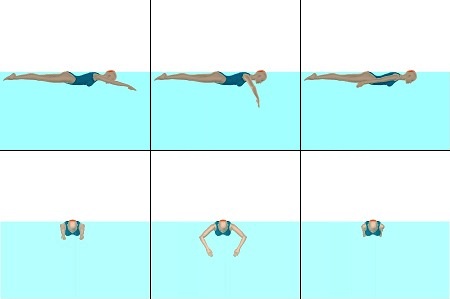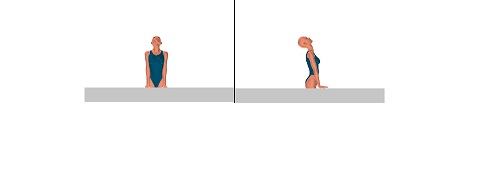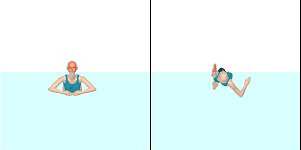Improving Performance in Swimming: Learning Strategies for Basic Technology
Rod Havriluk, Ph.D.
Swimming World, 2008, 49(7), 36.
Improving performance in swimming by changing technique is a long and difficult process. Due to budget constraints and inadequate staffing, coaches are often limited to the most basic technology for technique instruction – naked eye observation and verbal communication. Although these methods have limitations, their effectiveness greatly improves when using several learning strategies.
For example, to improve a swimmer’s streamline (Figure 1), an instructor might use an expression such as “make the arms straight.” While some swimmers may interpret this information exactly the way the instructor intends, others are likely to respond in a different way, even after a demonstration. However, if specific “cues” precisely describe the arm position, there is a greater chance a swimmer will exactly comply with the skill.
Language Strategy – Precise Cue Phrases
A cue is most effective if the language syntax is precise and unambiguous. For example, three cues clarify the streamline arm position:
- upper arms squeeze the ears;
- elbows extend completely; and
- one hand rests on top of the other hand.
Each of these cues includes a body part (e.g. upper arms), an action (e.g. squeeze), and a reference(e.g. ears). Skill compliance only requires moving the body part in the manner described by the actionto the extent specified by the reference.
The reference is often another body part, but can also be the surface of the water or the range of motion at a joint. In some cases, these references are fairly easy for a swimmer to track. At the beginning of the breaststroke arm recovery, making the fingertips of one hand touch the fingertips of the other hand is straightforward (Figure 2). However, in backstroke making the hand enter directly behind the shoulder is more difficult. Additional cues (such as the elbow locks at the end of the push phase) are often necessary for skills that are more complicated.
Figure 2. Using body parts as references for cues in breaststroke (left) and backstroke (right).
There are so many skills for all the starts, turns, finishes, and strokes that a simplified language is imperative. A standardized syntax provides a common lingo to improve communication between coach and swimmer, while expediting the learning process. In addition to the wording, the effectiveness of cues depends on strategies for demonstration, sensory input, instruction, feedback, practice, drills, exercises, interaction, and systemization.
Demonstration Strategy – Accurate Orientation of Body Parts
Precise language is a start, but an accurate demonstration is also essential. The exact orientation of body parts is necessary for swimmers to understand the cues. A coach can demonstrate a skill from the pool deck and then have a proficient swimmer perform in the pool. Additional verbal information may be appropriate. The deck demonstration also signals a cue to a swimmer during training when verbal communication is not possible.
Sensory Input Strategy – Visual and Kinesthetic Cues
All of the examples above are kinesthetic cues – they require “feeling” the relationship of the body parts. Because humans prefer visual information, visual cues are more effective. For example, a kinesthetic cue can position the head in the streamline, but a visual cue to adjust the head to look at the reference ofthe bottom of the pool directly beneath the head is information that a swimmer can precisely process.
Visual cues are particularly effective for controlling arm motions within the swimmer’s view. Cues for initiating elbow flexion at the beginning of the pull in freestyle and butterfly are examples. During most of each stroke cycle, however, body parts are outside of the swimmer’s visual field and kinesthetic cues are required.
In addition to taking advantage of the natural preference for visual information, there is another concern for making these cues as effective as possible: the swimmer must actually focus on the body parts within the field of view. When asked about their concentration, swimmers who are untrained in tracking visual cues usually respond that they are watching “nothing.” Remembering the words of a great American philosopher (Yogi Berra) can improve focus on visual cues: “sometimes, if you’re looking, you just might see something.”
Instructional Strategy – From Proximal to Distal Body Parts
Cues (both visual and kinesthetic) must first target movements of body parts close (proximal) to the center of the body, as opposed to body parts farther away (distal). Cues for head and torso adjustments must be considered before cues for the limbs. Similarly, changes in the angle at the shoulder (the most proximal joint of the arm) must generally precede changes at the elbow and wrist.
For example, instructors often tell beginning swimmers to “make big circles” with their arms. Cues that describe a circular motion of a straight arm only explain motion about the shoulder joint. As the shoulder joint determines how the entire arm moves, it is necessary to address skills for the shoulder before adjusting the elbow and wrist. Conversely, modifying wrist actions before changing the shoulder and elbow motions is less productive, as distal changes require readjustment after making proximal changes.
Feedback Strategy – To Evaluate Compliance with Instruction
Cues are presented by the coach to instruct (i.e. specify the model for performance). An equally important use of cues is feedback to describe the swimmer’s actual technique. For example, if an instruction for backstroke is that the hand enters directly behind the shoulder, feedback that the hand entered directly behind the head pinpoints the discrepancy.
The difference between the coach’s instruction and swimmer’s performance decreases with sufficient feedback. Dialog between coach and swimmer is critical to resolve differences between the swimmer’s actual and perceived performance.
Practice Strategy – Short, Slow, Nonbreathing Swims
Focusing on cues is difficult. Tracking cues for distal body parts moving at a fast speed is extremely hard. The focus is somewhat easier when swimming slowly. Many swimmers do not swim slowly enough to control their technique. One practice strategy for improving control is to move the hands at the slowest, continuous speed throughout the stroke cycle.
Concentration on cues also improves if the head remains in the nonbreathing position for multiple successive strokes. A swimmer is more certain of cues within his/her field of view if the view is not changing. When swimming slowly, there is less fatigue and it is possible to perform more nonbreathing strokes.
It is also helpful to swim short distances (10 to 25 yards) to minimize fatigue and increase the number of nonbreathing repetitions. As a minimum, swimmers can alternate nonbreathing and breathing stroke cycles, even in breaststroke. If some training time is devoted to a practice strategy with slow, nonbreathing swimming, swimmers can constantly focus on the cues.
While the slow repetitions are vital for modifying technique, it is also essential to practice the changes at a fast speed. Maintaining technique changes at racing speed requires gradually increasing practice speed while maintaining focus on the cues. The speed transition can occur within a swim, or over a series of swims. It is always necessary, however, to revert to a slow speed to focus on new cues.
Drill Strategy – Isolate Focus on Select Cues with a Simplified Swimming Motion
In addition to the practice strategy for swimming the whole stroke, drills address stroke components. Drills are most effective when they closely approximate the swimming stroke, yet modify the motion to isolate a specific cue or series of cues. The cue isolation minimizes distractions and improves focus.
One butterfly arm drill is to swim without breathing, kicking, or undulating (Figure 3). The head, torso, and legs remain motionless and parallel to the surface. With extraneous motions removed, a swimmer can more easily control arm movements to comply with visual cues on the pull phase and kinesthetic cues on the push phase.

Figure 3. Butterfly arm drill without breathing, kicking, or undulating.
Exercise Strategy – Isolate Focus on Select Cues for Immediate Feedback
Similar to drills, exercises can simulate elements of swimming strokes to isolate focus on certain cues. The added advantage of exercises is that the swimmer is stationary to allow constant communication with the coach. Noncompliance with a cue can be instantly corrected.
For example, a “wall push-up” is an exercise at the side of the pool where a swimmer places his/her hands on the top of the wall and pushes his/her body out of the water (Figure 4). If a swimmer simulates the butterfly breathing position with the neck extended completely, he/she can better appreciate the full range of motion at the neck. Once a swimmer is in position, a coach can provide feedback until the swimmer complies with the cue.
 Figure 4. Wall push-up exercise.
Figure 4. Wall push-up exercise.
Interaction Strategy – Frequency of Coach-Swimmer Communications
Because swimmers normally need numerous cue treatments with a variety of strategies to master a skill, increasing the frequency of coach-swimmer interactions expedites learning. Although increasing interactions seems obvious, coaches are severely limited by time in a training session. If a coach has 30 swimmers and 60 minutes for technique instruction, each swimmer receives a maximum of 2 minutes of individual attention. The net result might be a single technique interaction per swimmer per workout. Unfortunately, it is extremely uncommon for a single treatment to produce a permanent change.
One strategy to increase the frequency of interactions is for the coach to provide a cue reminder before a swim and feedback about that cue immediately after the swim. Another strategy is for the coach to ask the swimmer for his/her evaluation of compliance with a cue. Since the opportunity for coaches to interact with swimmers is restricted, a plan to use any available time is critical.
Providing an adequate number of interactions with swimmers may be one of the biggest challenges facing a coach. Even the most interactive coaches do not have sufficient training time to progress every swimmer through all the advanced skills. (As research shows, even the fastest swimmers have technique limitations.) Swimmers often supplement training with technique clinics and private lessons to get the necessary instruction and feedback frequency. However, an increase in interaction during team training will not only improve technique, but also the relationship of coach and swimmer.
Systemization Strategy – A Common Language for Coaches and Swimmers
While the efforts of any one coach to use learning strategies are beneficial, a team-wide implementation is priceless. The cue syntax provides a common language for both coaches and swimmers. If all the coaches on a team implement the standardized format, swimmers can easily transition from group to group, as they progress. A systematic language strategy for the entire team ensures that swimmers receive the same information from all members of the coaching staff.
A systematic implementation also means that the coaching staff must have a training program to ensure that all coaches are using the same language. Regular meetings are necessary to maintain the language with existing staff and instruct new staff members. There are hundreds of cues for developing an advanced level of technique, so the commitment of the staff is considerable. The substantial investment in time improves consistency in instruction across the team and produces more technically proficient swimmers.
Summary
The effectiveness of basic technology (naked eye observation and verbal communication) improves when using a common language for swimming technique, as well as additional strategies to expedite learning. Strategies include:
- precisely wording specific cues to simplify communication;
- accurately demonstrating the orientation of body parts;
- taking full advantage of both visual and kinesthetic sensory input;
- progressing with instructional information from proximal to distal body parts;
- providing feedback about compliance with cues;
- practicing short swims at a slow speed with limited breathing and constant focus;
- including drills and exercises to isolate focus on select cues;
- increasing the frequency of coach-swimmer interactions; and
- implementing a team-wide system to ensure consistency in technique instruction.
Instructional cues play a vital role in learning skills. Cues clarify the orientation of body parts, minimize the chance of misinterpretation, and expedite the learning process. Strategies for improving technique also improve communication between coach and swimmer. In addition, all of the cue strategies to improve basic technology are consistent with intermediate (e.g. underwater video) and advanced (e.g. synchronized video and force data) technology. Even if a coach is limited to basic technology, however, learning strategies make it far more effective.
Regardless of the strategies a coach uses to maximize the effectiveness of technique instruction, ultimately the swimmer is responsible for making the changes. A swimmer’s progress is dependent on responding to the coach’s instruction and feedback. However, swimmers who constantly focus on cues without prompting from the coach will enjoy the fastest performance gains.


